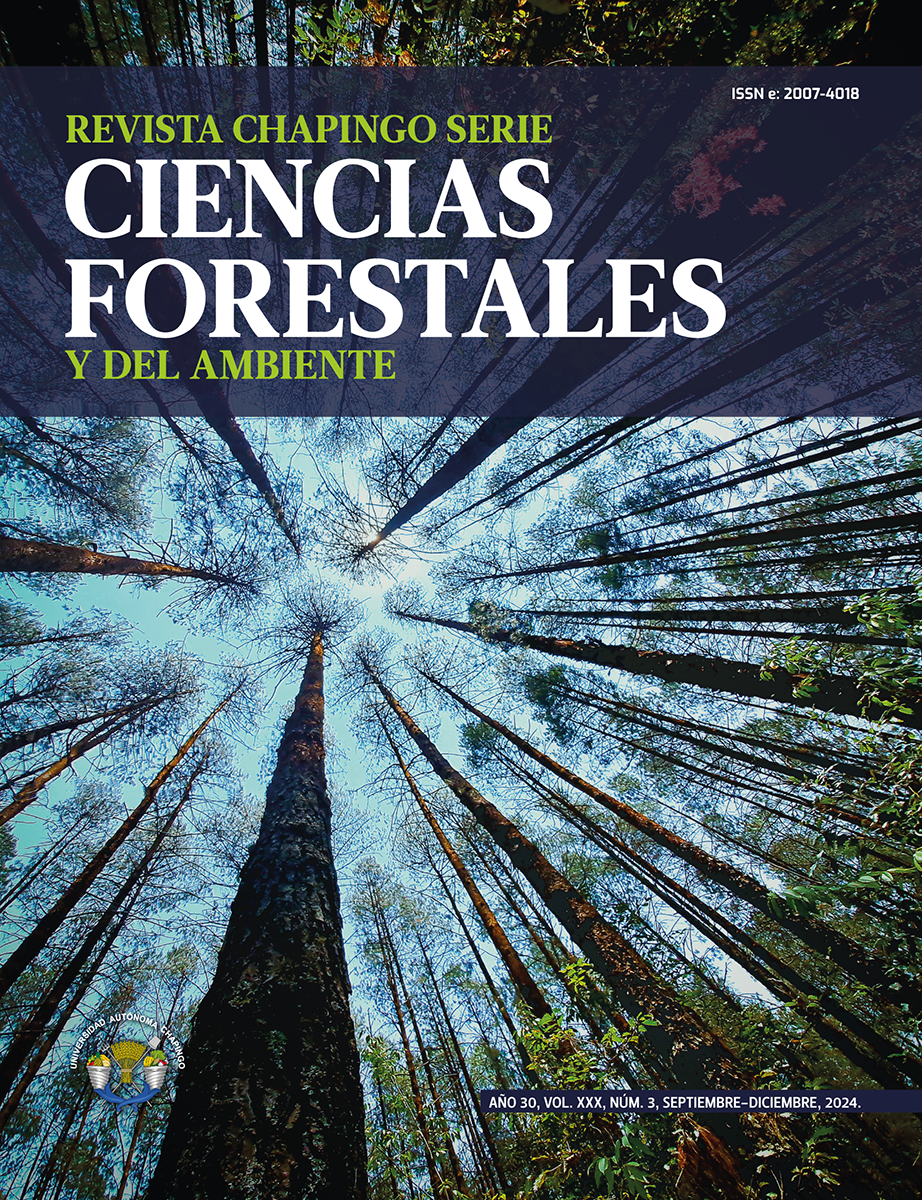Abstract
Introduction. Fuel studies provide information on fire danger, fire behavior, greenhouse gas emissions, and fuel management.
Objective. To establish relationships between fuel variables, leaf area index, and solar radiation to estimate fuel loads in a Pinus hartwegii Lindl. forest and subalpine grassland at the Iztaccíhuatl- Popocatépetl National Park.
Materials and methods. Fuels (load, cover, height, or depth), forest stand (tree measurement variables), and solar radiation (diffuse, direct, total area and clearing) were sampled. Relationships between variables were determined using linear regression using the coefficient of determination, significance, normality, homoscedasticity, multicollinearity, and autocorrelation.
Results and discussion. In the forest, the average load was 27.9 Mg∙ha-1, with nearly 60 % of
leaflitter and fermentation layer. There are direct relationships between grass cover and clearing; woody material load and leaf area index; and total fuel load with leaflitter depth and fermentation layer. Conditions with higher radiation promote greater grass load, while low radiation facilitates the accumulation of woody materials, leaflitter, and the fermentation layer. In the grassland, the load reached 6.8 Mg∙ha-1, and there was a direct relationship between total fuel load and cover.
Conclusions. In the P. hartwegii forest and grassland, statistical models were found that relate forest fuel loads with radiation variables or with variables specific to the fuels, which expedites estimates and supports decisions for fuel management.
References
Bautista-Rentería-Ánima, J., Treviño-Garza, E. J., Návar-Chaidez, J. de J., Aguirre-Calderón, O. A., & Cantú-Silva, L. (2005). Caracterización de combustibles leñosos en el ejido Pueblo Nuevo, Durango. Revista Chapingo. Serie Ciencias Forestales y del Ambiente, 11(1), 51—56. https://www.redalyc.org/articulo.oa?id=62911108
Brown, J. K. (1974). Handbook for inventorying downed woody material. General Technical Service INT-16. USDA Forest Service, Intermountain Forest and Range Experiment Station.
Caballero-Cruz, P., Santiago-Juárez, W., Martínez-Santiago, D., Cruz- Santiago, O. L., Pérez-Silva, E. R., & Aguirre-Calderón, O. A. (2018). Combustibles forestales y susceptibilidad a incendios de un bosque templado de la Mixteca Alta, Oaxaca, México. Foresta Veracruzana, 20(1), 9—14. https://www.redalyc.org/journal/497/49757295003/html/
Castañeda-Rojas, M. F., Endara-Agramont, A. R., Villers-Ruiz, M. L., & Nava-Bernal, E. G. (2015). Evaluación forestal y de combustibles en bosques de Pinus hartwegii en el Estado de México según densidades de cobertura y vulnerabilidad a incendios. Madera y Bosques, 21(2), 45—58. https://doi.org/10.21829/myb.2015.212444
Chávez-Durán, A. A., Bustos-Santana, A., Chávez-Durán, H. M., De la Mora-Orozco, C., Flores-Garnica, J. G., Rubio-Camacho, E. A., & Xelhuazntzi-Carmona, J. (2021). Distribución espacial de cargas de combustibles en una parcela de muestreo de pino- encino. Revista Mexicana de Ciencias Forestales, 12(65), 112—133. https://doi.org/10.29298/rmcf.v12i65.787
Comisión Nacional de Áreas Naturales Protegidas (CONANP). (2013). Programa de manejo. Parque Nacional Iztaccíhuatl-Popocatépetl. https://www.conanp.gob.mx/que_hacemos/pdf/programas_manejo/2014/IZTA_POPO_2014.pdf
Delta T. Company. (1998). Hemiview canopy analysis software. Version 2.1 SR4. United Kingdom: Delta T. Devices Ltd.
Flores-Garnica, J. G., Wong-González, J., & Paz-Pellat, F. (2018). Camas de combustibles forestales y carbono en México. Madera y Bosques, 24(sup. esp. e2401893), 1—15. doi: 10.21829/myb.2018.2401893
Hurzhii, R. V., Yavorovskyi, P. P., Sydorenko, S. H., Levchenko, V. B., Tyshchenko, O. M., Tertyshnyi, A. P., & Yakubenko, B. Y. (2021). Trends in forest fuel accumulation in pine forests of Kyiv Polissya in Ukraine. Folia Forestalia Polonica, Seria A (Forestry), 63(2), 116—124. doi: 10.2478-ffp-2021-0013
Islas-Madrid, G. E., Rodríguez-Trejo, D. A., & Martínez-Hernández, P. A. (2013). Diversidad del sotobosque y radiación solar en un bosque de Pinus hartwegii Lindl. con quema prescrita. Revista Mexicana de Ciencias Forestales, 4(15), 25—40. https://www.scielo.org.mx/pdf/remcf/v4n15/v4n15a3.pdf
Krebs, C. J. (2016). Ecology. The experimental analysis of distribution and abundance. Pearson.
Lambers, H., & Oliveira, R. S. (2019). Plant physiological ecology (3rd. ed.). Springer.
Liang, Y., Li, J. M., Zhao, F., Zhang, Y., Kong, T., & Nurgul, M. (2017). Surface fuel loads of Tianshan spruce forests in the central Tianshan Mountains and the impact factors. Scientia Silvae Sinicae, 53(12), 153—160. https://www.cabdirect.org/cabdirect/abstract/20183217164
Miranda, F., & Hernández-Xolocotzi, E. (2014). Los tipos de vegetación de México y su clasificación. Sociedad Botánica de México- CONABIO-FCE-Ed. Científicas Universitarias.
Morfín-Ríos, J. E., Jardel-Peláez, E., Alvarado-Celestino, E., & Michel- Fuentes, J. M. (2012). Caracterización y cuantificación de combustibles forestales. CONAFOR-Universidad de Guadalajara. https://camafu.org.mx/wp-content/uploads/2017/12/Caracterizacion- y-cuantificacion-de-combustibles-Forestales.pdf
Quintero-Gradilla, S. D., Jardel-Peláez, E. J., Cuevas-Guzmán, R., García-Oliva, F., & Martínez-Ytizar, A. (2019). Cambio postincendio en la estructura y composición del estrato arbóreo y carga de combustibles en un bosque de Pinus douglasiana de México. Madera y Bosques, 25(3), e2531888, 1—14. https://doi.org/10.21829/myb.2019.2531888
Rodríguez-Trejo, D. A. (2014). Incendios de vegetación. Su ecología, manejo e historia. (vol. 1.). CP-UACh-SEMARNAT-CONAFOR-CONANP- PNIP.
Rodríguez-Trejo, D. A., & Sierra-Pineda, A. (1996). Evaluación de los combustibles forestales en los bosques del Distrito Federal. Revista Ciencia Forestal en México, 20(77), 193—218. http://cienciasforestales.inifap.gob.mx/index.php/forestales/article/ view/1028/2343
Rodríguez-Trejo, D. A., Rodríguez-Aguilar, M., Villanueva-Morales, A., & Bonilla-Padilla, E. (2021). Estimación de combustibles en bosque de Quercus crassifolia en México central. Revista Incendios y Riesgos Naturales, 4, 33—35. https://revistarirn.org/wp-content/uploads/2021/09/RIyRN_Septiembre2021_n04hq. pdf
Rzedowski, J. (2010). Principales comunidades vegetales. In J. Rzedowski, & G. Calderón de Rzedowski (Coords.), Flora fanerogámica del Valle de México (pp. 47—54). CECSA. https://www.biodiversidad.gob.mx/publicaciones/librosDig/pdf/ Flora_del_Valle_de_Mx1.pdf
Scott, A. C., Bowman, D. M. J. S., Bond, W. J., Pyne, S. J., & Alexander, M. E. (2014). Fire on Earth. An introduction. Wiley, Blackwell.

This work is licensed under a Creative Commons Attribution-NonCommercial 4.0 International License.
Copyright (c) 2024 Revista Chapingo Serie Ciencias Forestales y del Ambiente



